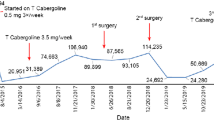Abstract
OBJECTIVE
Dopamine agonists (DA) are the treatment of choice in patients with macroprolactinomas. Brain and optic chiasm herniation are unusual complications following treatment with DA.
REPORT
We present a case of a giant prolactinoma complicated by visual deterioration following cabergoline treatment. A 42-year-old man was admitted with seizures, right visual loss and visual defect in the upper left temporal quadrant. Magnetic resonance imaging (MRI) identified a giant adenoma, which proved to be a prolactinoma, compressing the optic chiasm and extending into the suprasellar region. Treatment with cabergoline was initiated resulting in improvement in visual fields, tumor shrinkage and prolactin level decrease. Five months later and despite tumor reduction, a deterioration of his visual fields was observed. The second MRI revealed brain and optic chiasmal herniation into the pituitary sella. Cabergoline dose was reduced and surgical resection of the adenoma along with untethering of the optic nerve was performed leading to improvement of the visual defects.
CONCLUSIONS
This report describes a rare case of brain and optic chiasmal herniation attributed to DA therapy for a macroprolactinoma. It is important for clinicians to examine visual fields and promptly identify any visual deterioration in patients with macroprolactinomas receiving DA treatment.
Similar content being viewed by others
References
Schlechte JA, 2003 Clinical practice. Prolactinoma. N Engl J Med 349: 2035–2041.
Gillam MP, Molitch ME, Lombardi G, Colao A, 2006 Advances in the treatment of prolactinomas. Endocr Rev 27: 485–534.
Melmed S, Casanueva FF, Hoffman AR, et al, 2011 Diagnosis and treatment of hyperprolactinemia: an Endocrine Society clinical practice guideline. J Clin Endocrinol Metab 96: 273–288.
Colao A, Savastano S, 2011 Medical treatment of prolactinomas. Nat Rev Endocrinol 7: 267–278.
Burrow GN, Wortzman G, Rewcastle NB, Holgate RC, Kovacs K, 1981 Microadenomas of the pituitary and abnormal sellar tomograms in an unselected autopsy series. N Engl J Med 304: 156–158.
Corsello SM, Ubertini G, Altomare M, et al, 2003 Giant prolactinomas in men: efficacy of cabergoline treatment. Clin Endocrinol (Oxf) 58: 662–670.
Shrivastava RK, Arginteanu MS, King WA, Post KD, 2002 Giant prolactinomas: clinical management and long-term follow up. J Neurosurg 97: 299–306.
Vroonen L, Jaffrain-Rea ML, Petrossians P, et al, 2012 Prolactinomas resistant to standard doses of cabergoline: a multicenter study of 92 patients. Eur J Endocrinol 167: 651–662.
Knoepfelmacher M, Gomes MC, Melo ME, Mendonca BB, 2004 Pituitary apoplexy during therapy with cabergoline in an adolescent male with prolactin-secreting macroadenoma. Pituitary 7: 83–87.
Leong KS, Foy PM, Swift AC, Atkin SL, Hadden DR, MacFarlane IA, 2000 CSF rhinorrhoea following treatment with dopamine agonists for massive invasive prolactinomas. Clin Endocrinol (Oxf) 52: 43–49.
Jones SE, James RA, Hall K, Kendall-Taylor P, 2000 Optic chiasmal herniation—an under recognized complication of dopamine agonist therapy for macroprolactinoma. Clin Endocrinol (Oxf) 53: 529–534.
Bangash MH, Clarke DB, Holness RO, 2006 Brain & chiasmal herniations into sella after medical treatment of prolactinoma. Can J Neurol Sci 33: 240–242.
Dhanwal DK, Sharma AK, 2011 Brain and optic chiasmal herniations into sella after cabergoline therapy of giant prolactinoma. Pituitary 14: 384–387.
Gkekas N, Primikiris P, Georgakoulias N, 2013 Untethering of herniated left optic nerve after dopamine agonist treatment for giant prolactinoma. Acta Neurochir (Wien) 155: 495–496.
Shimon I, Benbassat C, Hadani M, 2007 Effectiveness of long-term cabergoline treatment for giant prolactinoma: study of 12 men. Eur J Endocrinol 156: 225–231.
Acharya SV, Gopal RA, Menon PS, Bandgar TR, Shah NS, 2010 Giant prolactinoma and effectiveness of medical management. Endocr Pract 16: 42–46.
Colao A, Di Sarno A, Landi ML, et al, 1997 Long-term and low-dose treatment with cabergoline induces macroprolactinoma shrinkage. J Clin Endocrinol Metab 82: 3574–3579.
Molitch ME, 2005 Pharmacologic resistance in prolactinoma patients. Pituitary 8: 43–52.
Davis JR, Sheppard MC, Heath DA, 1990 Giant invasive prolactinoma: a case report and review of nine further cases. Q J Med 74: 227–238.
Besser M, 1993 Criteria for medical as opposed to surgical treatment of prolactinomas. Acta Endocrinol (Copenh) 129: Suppl 1: 27–30.
Pia HW, Grote E, Hildebrandt G, 1985 Giant pituitary adenomas. Neurosurg Rev 8: 207–220.
Kaufman B, Tomsak RL, Kaufman BA, et al, 1989 Herniation of the suprasellar visual system and third ventricle into empty sellae: morphologic and clinical considerations. AJR Am J Roentgenol 152: 597–608.
Taxel P, Waitzman DM, Harrington JF Jr, et al, 1996 Chiasmal herniation as a complication of bromocriptine therapy. J Neuroophthalmol 16: 252–257.
Chuman H, Cornblath WT, Trobe JD, Gebarski SS, 2002 Delayed visual loss following pergolide treatment of a prolactinoma. J Neuroophthalmol 22: 102–106.
Lundin P, Bergström K, Nyman R, Lundberg PO, Muhr C, 1992 Macroprolactinomas: serial MR imaging in longterm bromocriptine therapy. AJNR Am J Neuroradiol 13: 1279–1291.
Wu ZB, Su ZP, Wu JS, Zheng WM, Zhuge QC, Zhong M, 2008 Five years follow-up of invasive prolactinomas with special reference to the control of cavernous sinus invasion. Pituitary 11: 63–70.
Raverot G, Jacob M, Jouanneau E, et al, 2009 Secondary deterioration of visual field during cabergoline treatment for macroprolactinoma. Clin Endocrinol (Oxf) 70: 588–592.
Losa M, Mortini P, Barzaghi R, Gioia L, Giovanelli M, 2002 Surgical treatment of prolactin-secreting pituitary adenomas: early results and long-term outcome. J Clin Endocrinol Metab 87: 3180–3186.
Liu JK, Weiss MH, Couldwell WT, 2003 Surgical approaches to pituitary tumors. Neurosurg Clin N Am 14: 93–107.
Musleh W, Sonabend AM, Lesniak MS, 2006 Role of craniotomy in the management of pituitary adenomas and sellar/parasellar tumors. Expert Rev Anticancer Ther Suppl 9: 79–83.
Decker RE, Carras R, 1977 Transsphenoidal chiasmapexy for correction of posthypophysectomy traction syndrome of optic chiasm. Case report. J Neurosurg 46: 527–529.
Kubo S, Hasegawa H, Inui T, Tominaga S, Yoshimine T, 2005 Endonasal endoscopic transsphenoidal chiasmapexy with silicone plates for empty sella syndrome: technical note. Neurol Med Chir (Tokyo) 45: 428–432.
Author information
Authors and Affiliations
Corresponding author
Rights and permissions
About this article
Cite this article
Papanastasiou, L., Fountoulakis, S., Pappa, T. et al. Brain and optic chiasmal herniation following cabergoline treatment for a giant prolactinoma: wait or intervene?. Hormones 13, 290–295 (2014). https://doi.org/10.1007/BF03401344
Received:
Accepted:
Published:
Issue Date:
DOI: https://doi.org/10.1007/BF03401344




